iBooks
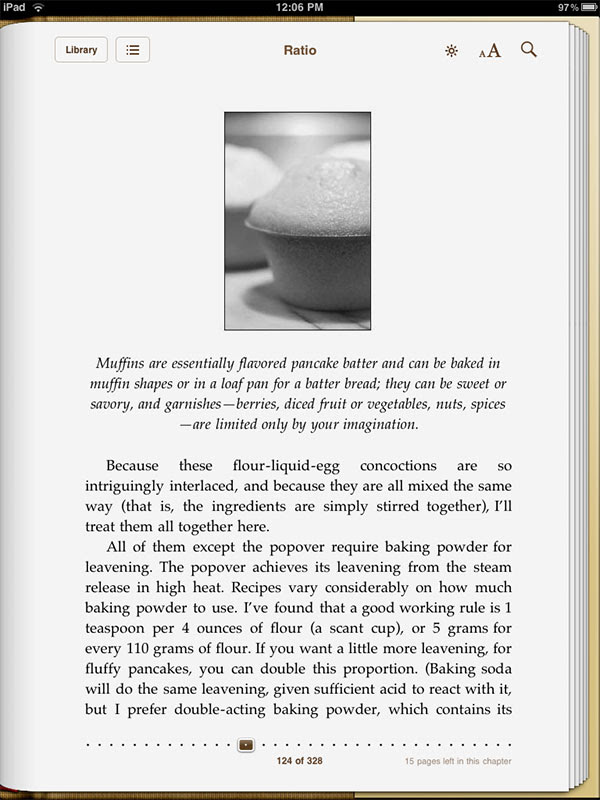
It’s not a pre-installed iPad application—most likely due to the complexity of international negotiations for individual, country-specific bookstores—but Apple’s eReader application iBooks is as key to the iPad’s appeal as anything found in the box. iBooks transforms the iPad into a competitor for Amazon’s Kindle, Barnes & Noble’s Nook, and numerous other dedicated “eBook” or “eReader” devices, with two obvious advantages out of the gate: the iPad has a full color screen, and it also runs hundreds of thousands of programs that competing devices could never hope to handle. On the flip side, the iPad costs more, and though it has a 10-hour battery, some of the black-and-white devices promise considerably longer stretches before recharging.
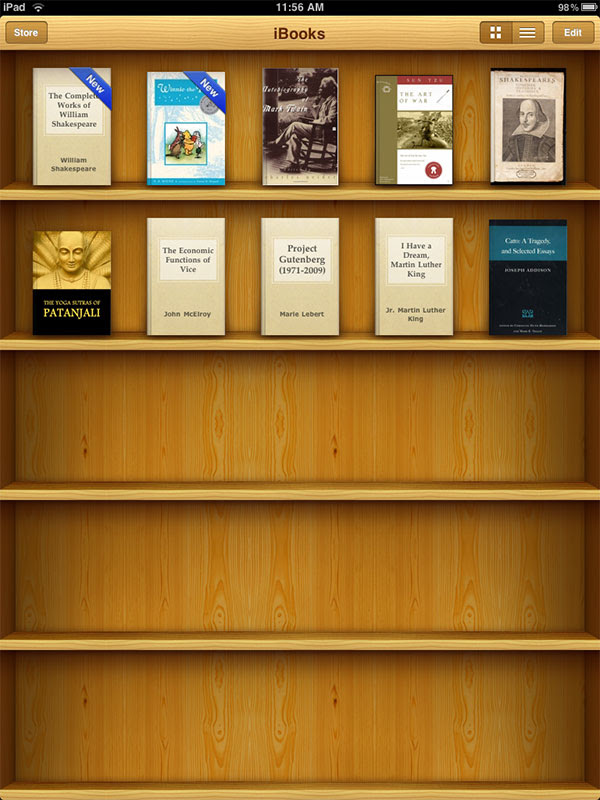
Unlike the iPod application, which depends upon the separate iTunes app for downloads, and the App Store, which stands apart from all the applications you can add to the iPad, iBooks is both a playback utility and a book store in one. First, a wooden bookshelf (the “Library”) appears with a 24- or 25-cover grid of books that can be clicked on individually and opened; alternately, clicking on a Store button in the upper left hand corner of the screen rotates the bookshelf around to reveal the iBookstore, Apple’s third on-board source of downloadable content for the iPad. Anything downloaded from the iBookstore automatically appears on the iBooks bookshelf for reading, and can be synchronized back to iTunes 9.1 for archival purposes. You can also download free ePub format books from the Internet, synchronize them to the iPad using iTunes, and read them from iBooks. The single most painful part of this process is finding the free ePub books—start with gutenberg.com’s Project Gutenberg—followed by the task of locating cover art for them; putting them in iTunes and bringing them to the iPad is otherwise as easy as “drag, drop, and sync.” Apple offers the Gutenberg content within its own store, saving you the hunt on the Internet, but its versions aren’t much better than the ones you’d find elsewhere.
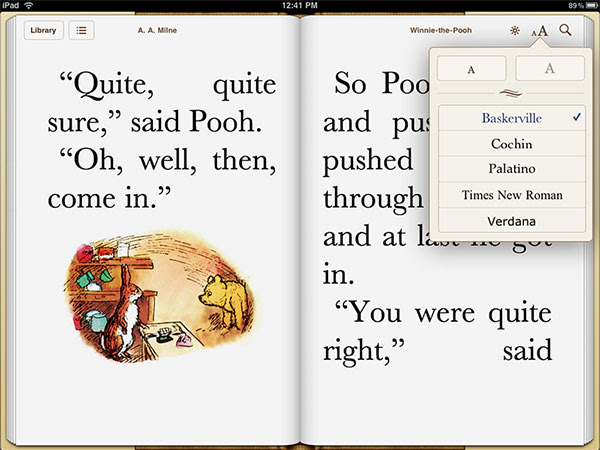
Though we’re reviewing the iBooks application separately, it suffices to say here that Apple’s implementation of the reader and iBookstore features isn’t surprising in any way—rather, this is just a more polished, simplified, and high-resolution version of earlier third-party apps such as Amazon’s Kindle for iPhone and iPod touch. The iPad’s 9.7” screen size enables it to display the text content of books at or far above the actual type size they originally appeared in, skipping through 10 sizes that max out at nearly .4” tall characters. Unlike Kindle, you can read a book either as a single vertical page or a set of two pages displayed horizontally, complete with page-turning animations. There’s a persistent bottom-of-screen timeline that lets you jump to any page automatically, top-of-screen icons to call up the clickable Table of Contents and your bookmarks, view in-line pictures—black and white or color ones—and the hardware’s screen lock to prevent the iPad from flipping into a different orientation when you hold the “book” on its side. All of this is much like the pre-iPad Kindle software for iPhones, but significantly better in most ways than the experience of reading on the dull-screened but longer-running Amazon Kindle hardware.
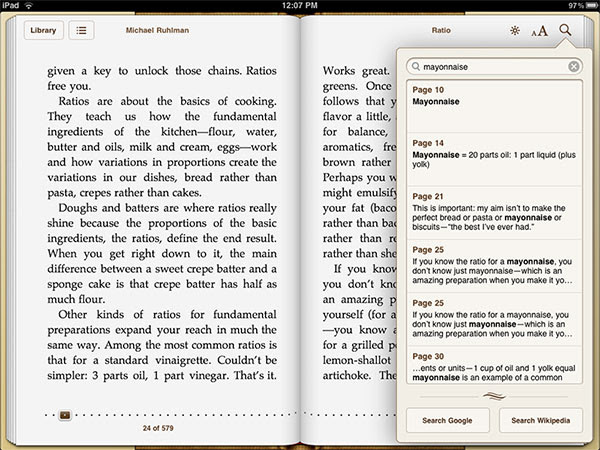
Unlike the iPhone Kindle application, however, iBooks includes its own automatic and manual screen brightness controls, a search feature, a set of five selectable fonts—the classical serifed Baskerville, Cochin, Palatino, and Times New Roman, plus the sans-serif Verdana—and access to a full dictionary that can instantly look up any word you tap and hold. The same tap and hold command brings up a tool for copying text, a bookmark button, and a search button to find other instances of the word. We tried reading the same book, Michael Ruhlman’s Ratio, in physical form, in iBooks, and in Amazon’s Kindle; while Ratio’s multiple fonts and page numbers weren’t preserved in either eBook version, the iBooks copy was considerably easier to hunt around in because of the search feature, more versatile because of its greater number and size of fonts, and at least as nice looking. Kindle’s only app advantages, a white on black mode and sepia mode, are minor league in the big picture, though Amazon’s ability to let you read your books on multiple devices is a non-trivial differentiator, for sure.
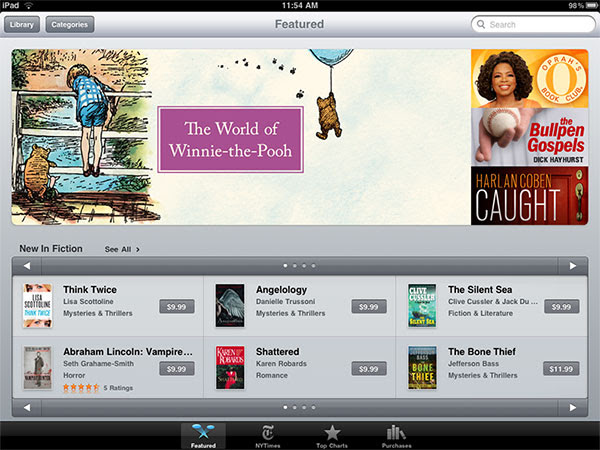
Apple’s iBookstore is essentially a stripped-down version of the iTunes application, with only four buttons—Featured, NY Times, Top Charts, and Purchases—at the bottom of the screen, the middle two providing one-touch access to different two-column lists of bestsellers. Currently, the iBookstore’s main page provides a full-width single-column view of spotlighted content, complete with a four-picture iTunes-style rotating banner, a New & Notable section, and four to six thumbnail promotional banners for individual books or collections. Clicking on any title brings up a dark overlaid window with cover art, descriptive text and alternate recommendations, plus buttons to buy the book or get a sample. Samples and books are both readable only on the iPad, and samples do not transfer back to iTunes on synchronization; books do so automatically.
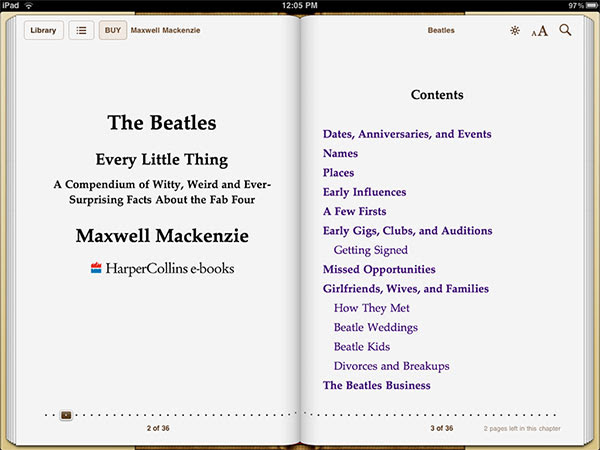
Even if the individual features of iBooks aren’t breathtaking, their collective simplicity and feel makes the iPad a superior overall device to the Kindle for reading and purchasing books. It’s not just that iBooks looks nicer than Amazon’s interface—tangibly more detailed text, even before you start playing with the fonts, brightness controls, or screen orientation—but that it’s more convenient for buying books: Amazon has kept purchasing buttons on its own web site rather than within the iPhone application, to avoid paying Apple 30% on every sale, and Apple uses the in-app two-click buy and confirm purchasing system to its advantage. There are no additional steps; everything just works, books appear on your Library bookshelf, and sync back to iTunes. It’s as easy as that. We’ll have more to say on iBooks in our separate review.
Third-Party Applications + Games
When Apple opened the App Store for iPhone and iPod touch in 2008, it had no concept of just how huge of a selling point third-party software would become for these devices, which previously ran nothing but Apple-developed applications—aside from minor hacks. Nearly two years later, the App Store is arguably the single most significant advantage Apple maintains over its competitors, a library of over 150,000 applications that may be 90-95% junk, but still would have 7,500 to 15,000 pieces of genuinely appealing software spread across numerous categories. Almost all of those applications, good, bad, or otherwise, except for ones that require hardware not found in the iPad, can be downloaded and run on the device without major problems. Some have small bugs, but given that apps such as Skype enable direct-from-iPad telephone calling and all sorts of games run perfectly, most people won’t care a bit.
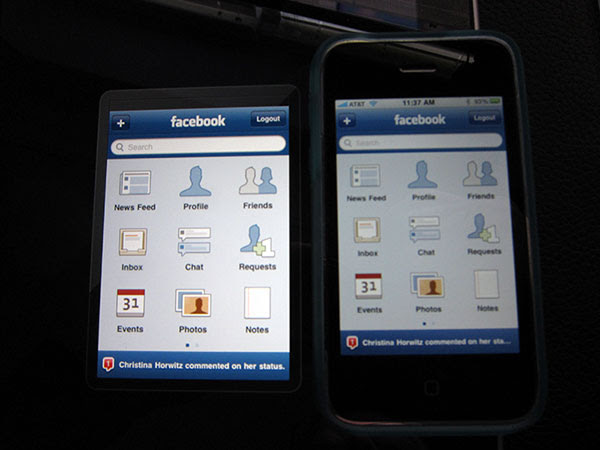
This isn’t to say that they look great on the iPad’s screen. You have the choice to run them at normal resolution, framing them with a huge black and gray bezel at “1x” size that’s actually slightly larger on the iPad’s screen than on the iPhone’s or iPod touch’s due to the slightly larger pixels on the iPad. Alternately, you can hit an on-screen button that says “2x.” This activates a mode that actually quadruples the pixels, filling the iPad’s display with an upscaled image that has roughly four times the surface area of a typical iPhone or iPod touch display. Apple leaves just enough black space around the edge of the “2x” image to keep the “1x” button at the bottom right, so that you can toggle between the sizes at any time. Your hand will likely cover it most of the time when you’re holding the iPad, so you won’t even notice that it’s there.


Pre-iPad apps we tried included Facebook, Pac-Man Championship Edition, Feed Me!, Old MacDonald, Edge, Line2, Skype, Plants vs. Zombies, and Ridge Racer Accelerated. Every app loaded a little faster than the iPhone 3GS, and most ran a little faster, as well—similar to the 2009 iPod touch. Line2 and Skype both enabled us to make Voice Over IP telephone calls directly from the iPad, with Skype successfully connecting to multiple Macs and Line2 calling directly to both a wired telephone number and a cell phone, all with great audio quality. The games were smooth and as easy to control as one could expect given the radically increased size of the iPad hardware; Facebook, Old MacDonald, and Feed Me! looked good enough to use on the iPad in either resolution mode, but could have benefitted from visual updates. We have no doubt that they’ll all receive them.

That’s because the library of iPad-compatible apps is growing at a very rapid clip. Some companies have decided to create combined iPod touch, iPhone, and iPad apps that work on all three devices, and have offered the new iPad features as free updates to their past applications, a wonderful bonus that many users wouldn’t have expected to receive. Several of these apps include Delivery Status Touch from Junecloud, Epicurious Recipes & Shopping List from Conde Nast, Kindle from Amazon, and Shanghai Mahjong from MobileAge.

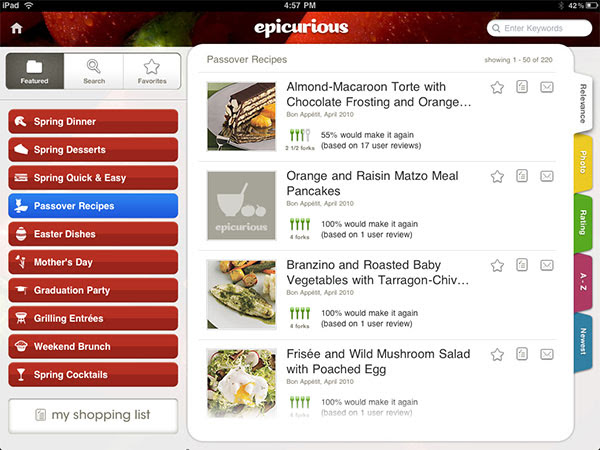
All of these apps look considerably better on the iPad than they did on the iPhone and iPod touch, largely preserving their prior feature sets with some iPad-specific bonuses. Most games have grown 50% or 100% of their original file size for the new device, which will further stretch the limited storage capacities of low-end iPads; combined iPod/iPhone/iPad apps may do the same to iPod touch and iPhone users, as well.

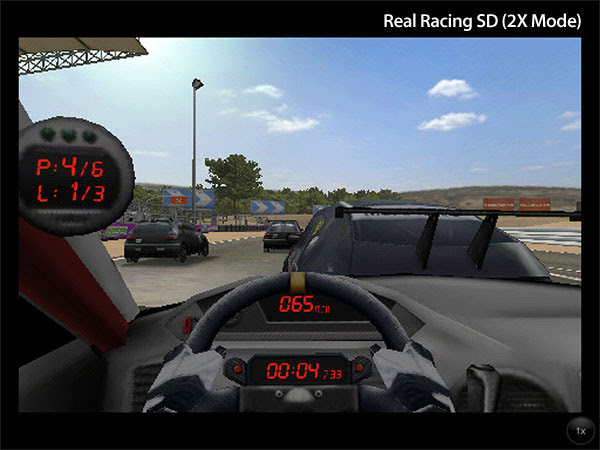
Other companies have released brand new standalone applications that in many cases reuse the core code from earlier iPod touch and iPhone games, with minor or substantial visual updates to take advantage of the iPad’s larger, more detailed screen. Gameloft’s N.O.V.A. is an example of a prior iPod and iPhone game that adds new gameplay elements and considerably better textures for the iPad, though surprisingly with only a modest increase in file size, growing from 161MB to 165.7MB. PopCap’s Plants vs. Zombies also received an HD version, growing from 34.8MB to 49.8MB; it received artwork that looks the same as the previously released Mac game, and has the iPhone’s touchscreen interface, now on a far better display. Real Racing HD, Sparkle HD, Radio Flare Redux HD, and Labyrinth 2 HD are amongst other worthwhile games that received primarily visual overhauls with small gameplay tweaks for the iPad, and all look great. AOL’s AIM, Tapulous’s Tap Tap Radiation, and The Iconfactory’s Twitterrific are all apps that changed dramatically from prior iPod and iPhone versions, but could use additional work to make better use of the iPad’s screen.

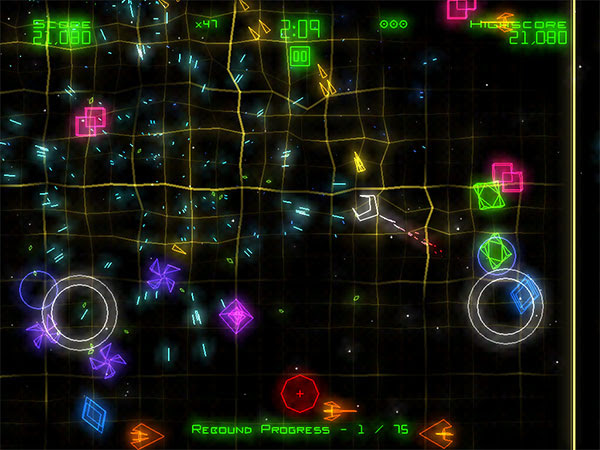
Still other companies have developed completely new applications that make use of the iPad’s comparatively huge touch surface for effects and gestures that either wouldn’t have worked on the iPhone or iPod touch at all, or work far better on a large screen than a small one. Apple’s collection of iWork apps—Keynote, Numbers, and Pages—are all off to a strong start on the iPad, and could never have been conceived of on smaller devices. Electronic Arts’ Mirror’s Edge is a 3-D action-platformer based loosely on the console version and an unreleased iPhone game, with Xbox-like graphics that wouldn’t have been possible on the pocket devices, and Geometry Wars is a port of an Xbox- and PlayStation hit shooter that similarly looks phenomenal on the iPad’s screen, with effects that would have crowded out the iPod touch or iPhone displays. As with the broader App Store, many of the other new iPad releases are junk, and they will grow in number as time goes on.
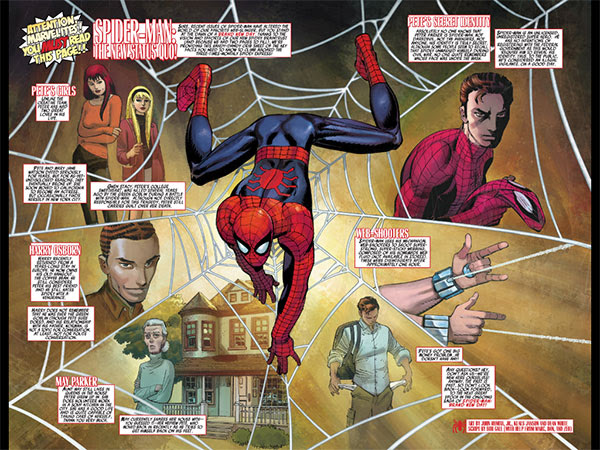
One category of applications that deserves special attention—but not praise—is the rapidly growing number of magazine- and newspaper-specific apps, which have been released with wildly differing interfaces, pricing schemes, and content over the past several days. Marvel has released a comic book viewer that provides access to a portion of its backcatalog of famous comics, using zooming and high-resolution images to let readers see details that would ordinarily have been all but invisible to the naked eye. The New York Times has released an application that offers a partial look at its newspaper, incorporating classic fonts and layout, as well as its photography. And Popular Science co-developed a completely new take on its print publication, using separately scrolling layers of text and images alongside a new interface that moves horizontally through multiple articles and vertically to dig deeper into individual ones.
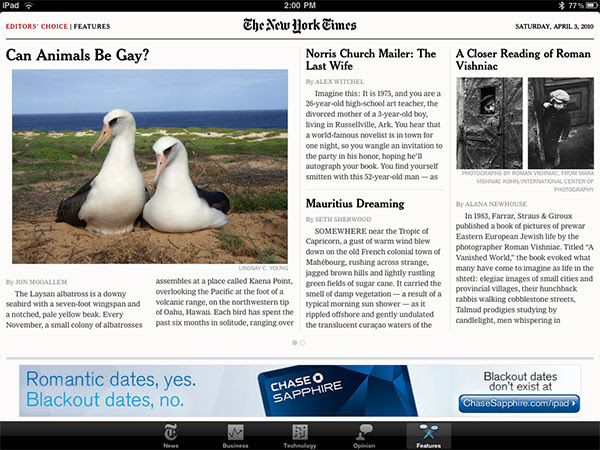
There’s no doubt that these applications represent a handful of the potential ways that printed publications could evolve into digital ones beyond their present web-based alternatives, and each one offers an individual and compelling experience when considered independently. The key problems are that these publications now litter the iPad’s Home screens with numerous additional icons, lack for any unified “iMagazinerack” or “iNewsstand” store, and have no value except when viewed on the iPad itself—two problems eliminated by Apple’s iBooks and iBookstore, though all three need to be addressed. It just doesn’t make sense to us to buy digital content at full print prices with no guarantee of portability onto other devices, no ability to read the content on computers, and no central organization system to keep everything from cluttering the iPad. Apple needs a next-generation color publication interface within iBooks to manage the mess that periodical publishers are about to make for themselves.
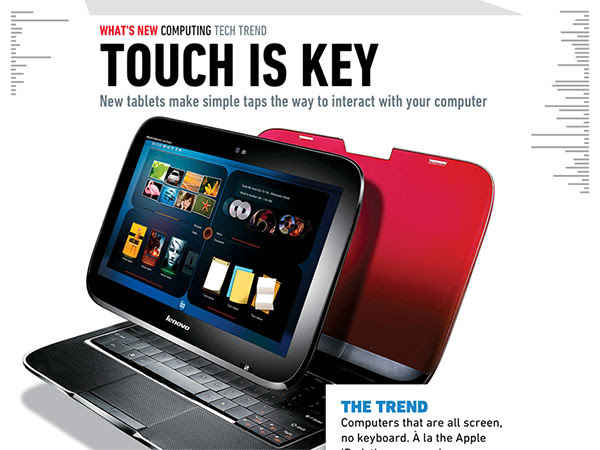
These are, of course, early days for the iPad’s applications library. Given that there were over 1,300 iPad-optimized apps available on the day of the iPad’s launch, and over 3,000 only three days later, there’s no doubt that the iPad will be aggressively supported by increasingly impressive software for the foreseeable future. It already has no shortage of powerful, diverse applications, and offers plenty of room for developers to impress people visually, sonically, in interfaces, and in fun factor. Reasonable price premiums for superior applications will be warranted.

One final note on third-party applications and games relates to battery life. As noted earlier in this review, the iPad’s battery lasts for longer than the promised 10 hours when browsing the web, and considerably longer when watching videos, but dips somewhat below it when other applications are taken into account. Our fully mixed test, with numerous Apple and third-party apps run in a “real world” mix of web surfing, video playing, e-mailing, gaming, and app use, ran for just shy of nine hours; in a pure game test with the 3-D-intensive N.O.V.A. HD and the mixed 2-D and movie-based Capcom’s Street Fighter IV, the iPad’s battery ran for 8 hours and 33 minutes. The iPad’s battery life for gaming and apps will obviously depend considerably on the specific apps you’re using, including their ongoing need for Internet access, use of the device’s 3-D hardware, and other considerations, but we consider the app and gaming run times we’ve seen to be very strong—far better than what we’d seen on the iPhone 3GS (~4 hours) in similar tests.

No comments:
Post a Comment